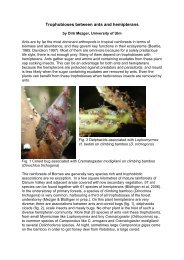Identification guide to the ant genera of Borneo - AntBase.net
Identification guide to the ant genera of Borneo - AntBase.net
Identification guide to the ant genera of Borneo - AntBase.net
Create successful ePaper yourself
Turn your PDF publications into a flip-book with our unique Google optimized e-Paper software.
Y. HASHIMOTO<br />
<strong>Borneo</strong> has tropical rain forests with <strong>the</strong> richest pl<strong>ant</strong> diversity in <strong>the</strong> world. This is one <strong>of</strong> reason why <strong>the</strong><br />
island has very diverse and unique <strong>ant</strong> fauna. Ant fauna in <strong>Borneo</strong>, especially in <strong>the</strong> canopy <strong>of</strong> tropical rain<br />
forests, has yet <strong>to</strong> be studied in detail. As <strong>the</strong> <strong>ant</strong> inven<strong>to</strong>ry are completed, many additional or new <strong>genera</strong><br />
and species should be found from <strong>Borneo</strong>.<br />
Notes on <strong>the</strong> keys<br />
The keys provided here are designed <strong>to</strong> identify workers only. This is because workers are <strong>the</strong> most<br />
commonly encountered caste <strong>of</strong> <strong>ant</strong>s in inven<strong>to</strong>ry. For sake <strong>of</strong> no-<strong>ant</strong> specialist user, I try <strong>to</strong> select and use<br />
easily observable characters in <strong>the</strong> keys. However, <strong>the</strong> use <strong>of</strong> a microscope is essential for identification <strong>of</strong><br />
<strong>ant</strong>s, because <strong>of</strong> <strong>the</strong>ir small size.<br />
To make reliable identification, it is advisable <strong>to</strong> check additional information <strong>to</strong> confirm your<br />
identification. The additional information includes <strong>the</strong> diagnostic characters and biological information <strong>of</strong><br />
taxonomic group, and <strong>the</strong> known distribution <strong>of</strong> <strong>the</strong> group. The book <strong>of</strong> Hölldobler and Wilson (1990),<br />
and Social insect Web-site (http://research.amnh.org/en<strong>to</strong>mology/social_insects/) can help you <strong>to</strong> search<br />
such information. This chapter also provide genus list <strong>of</strong> Bornean <strong>ant</strong>s, with <strong>the</strong>ir taxonomic references and<br />
biological data.<br />
In some case specimen may not identified certainly. When this happens, you try <strong>to</strong> use Bol<strong>to</strong>n’s key (1994).<br />
The illustrations provided here should help you <strong>to</strong> understand <strong>the</strong> taxonomic descriptions in <strong>the</strong> key.<br />
Preparation and Preservation <strong>of</strong> <strong>ant</strong> specimens<br />
The preparation <strong>of</strong> <strong>ant</strong> specimen is more import<strong>ant</strong> than<br />
<strong>the</strong> collection <strong>of</strong> specimen in <strong>the</strong> field. Big size organisms,<br />
like mammal and birds, can be identified in <strong>the</strong> field.<br />
However, small organisms, like <strong>ant</strong>s, are needed <strong>to</strong> preserve<br />
and prepare for identification in <strong>the</strong> labora<strong>to</strong>ry. The use<br />
<strong>of</strong> good preservation and preparation techniques serves<br />
<strong>to</strong> facilitate <strong>the</strong> identification <strong>of</strong> species and improves<br />
research value <strong>of</strong> specimen. Preparation and preservation<br />
techniques <strong>of</strong> <strong>ant</strong> specimens, here, are outlined.<br />
Fig. 1<br />
1) Pinning Specimens<br />
Commonly used specimen mounting <strong>to</strong>ols<br />
Insect specimens are mounted on pins so that <strong>the</strong>y may include a pinning block, forcep, pins, points, glue.<br />
be handled and examined with <strong>the</strong> greatest convenience.<br />
Therefore, for identification and taxonomic study, pinning specimens should be used. Fig. 1 shows typical<br />
<strong>to</strong>ols needed <strong>to</strong> make pinning specimens.<br />
Ants are usually <strong>to</strong>o small <strong>to</strong> be pinned directly, and so should be pinned as double mounts, i.e., <strong>the</strong><br />
specimen is glued <strong>to</strong> a card point and <strong>the</strong> point is pinned through <strong>the</strong> broad end with a No. 3 insect pin<br />
(Fig. 2). Card points are slender little triangles <strong>of</strong> stiff paper, which are cut from a strip <strong>of</strong> paper (<strong>the</strong>y should<br />
be no more than 10 mm long and 5 mm wide). The choice <strong>of</strong> good quality paper for card points is import<strong>ant</strong><br />
<strong>to</strong> prevent <strong>the</strong> specimen from working lose and rotating on <strong>the</strong> pin. To mount <strong>the</strong> specimens on card points,<br />
white glue is used commonly. Touch <strong>the</strong> tip <strong>of</strong> <strong>the</strong> point <strong>to</strong> <strong>the</strong> glue, and <strong>the</strong>n <strong>the</strong> point is attached <strong>to</strong> <strong>the</strong><br />
90 Part 3 - COLLECTING, HANDLING, IDENTIFICATION AND STORAGE FOR SELECTED GROUPS




